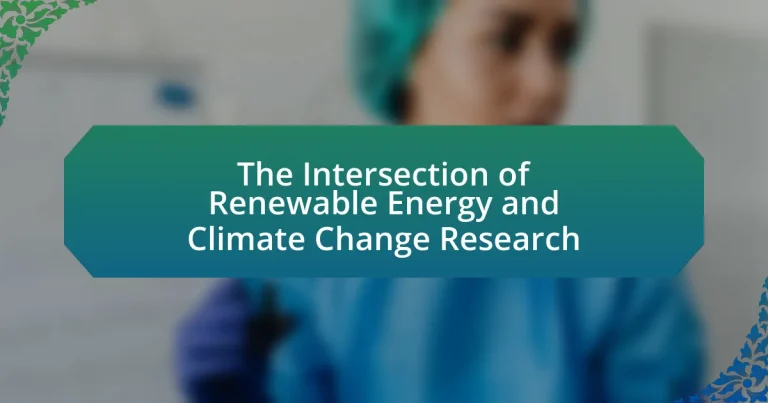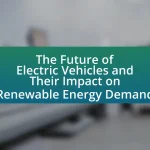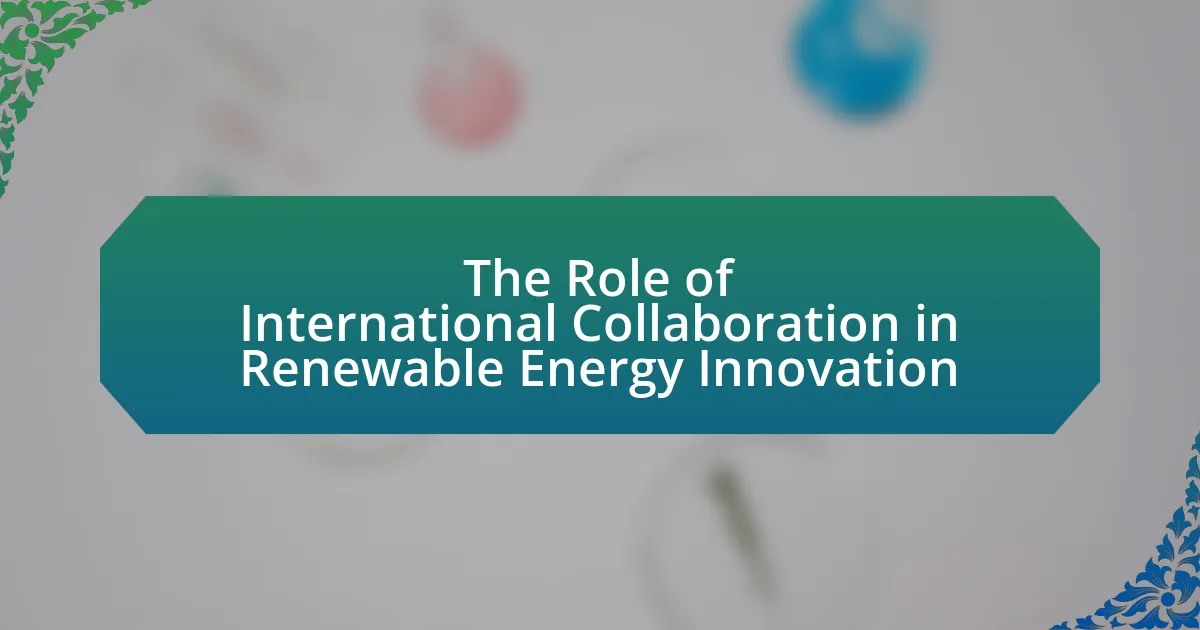The article examines the intersection of renewable energy and climate change research, emphasizing how renewable energy technologies, such as solar and wind power, can mitigate climate change by significantly reducing greenhouse gas emissions. It highlights the effectiveness of these energy sources in lowering global carbon emissions and discusses the importance of interdisciplinary research in developing innovative solutions to complex environmental challenges. Additionally, the article addresses current trends, technological advancements, and the impact of policy on renewable energy adoption, while also identifying barriers to widespread implementation and the need for collaborative efforts to enhance climate change mitigation strategies.
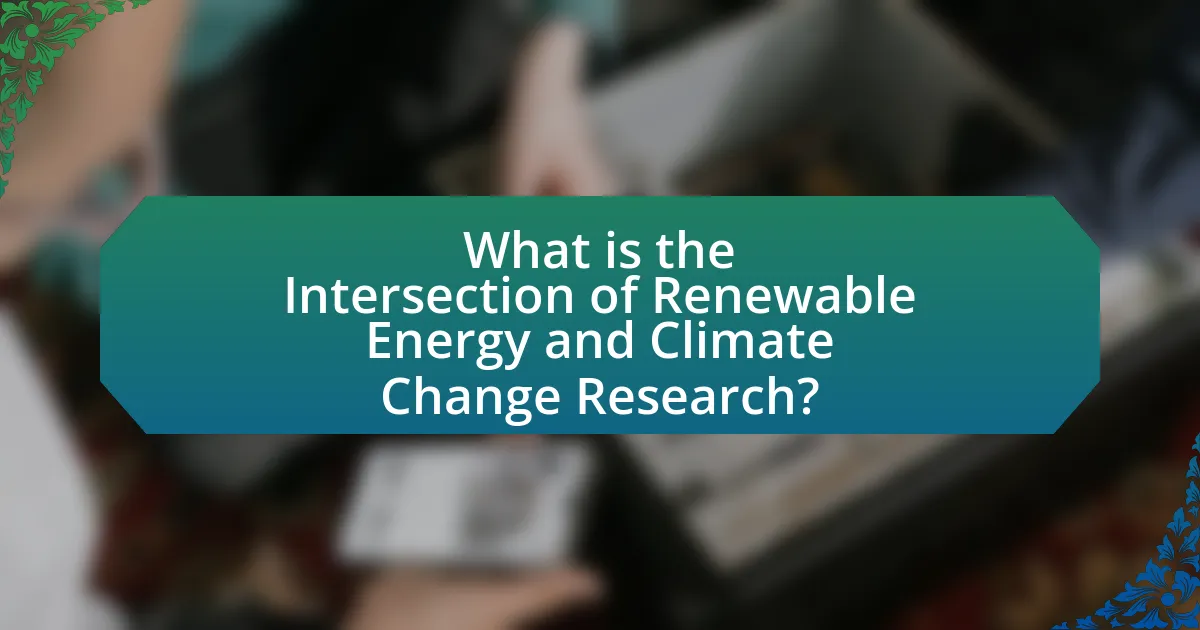
What is the Intersection of Renewable Energy and Climate Change Research?
The intersection of renewable energy and climate change research focuses on how the development and implementation of renewable energy sources can mitigate the impacts of climate change. Renewable energy technologies, such as solar, wind, and hydroelectric power, reduce greenhouse gas emissions, which are a primary driver of climate change. According to the Intergovernmental Panel on Climate Change (IPCC), transitioning to renewable energy could significantly lower global carbon emissions, helping to limit global warming to 1.5 degrees Celsius above pre-industrial levels. This relationship underscores the critical role that renewable energy plays in climate change mitigation strategies, as evidenced by numerous studies highlighting the potential for renewables to replace fossil fuels and decrease reliance on carbon-intensive energy sources.
How do renewable energy sources contribute to climate change mitigation?
Renewable energy sources contribute to climate change mitigation by significantly reducing greenhouse gas emissions compared to fossil fuels. For instance, according to the International Renewable Energy Agency (IRENA), transitioning to renewable energy could help reduce global carbon dioxide emissions by up to 70% by 2050. This reduction occurs because renewable energy technologies, such as solar, wind, and hydroelectric power, generate electricity without emitting carbon dioxide during operation. Furthermore, the deployment of renewables can displace the need for coal and natural gas, which are major contributors to climate change. The shift towards renewables not only addresses emissions but also promotes energy security and sustainability, further supporting climate change mitigation efforts.
What types of renewable energy are most effective in reducing greenhouse gas emissions?
Solar energy and wind energy are the most effective types of renewable energy in reducing greenhouse gas emissions. Solar energy systems, such as photovoltaic panels, convert sunlight directly into electricity, significantly lowering reliance on fossil fuels. According to the International Renewable Energy Agency (IRENA), solar power has the potential to reduce global CO2 emissions by up to 4.5 gigatons annually by 2030. Wind energy, generated through turbines, also plays a crucial role; it can reduce emissions by approximately 2.5 gigatons per year, as reported by the Global Wind Energy Council. Both energy sources contribute to a substantial decrease in greenhouse gas emissions, making them vital in combating climate change.
How does the adoption of renewable energy impact global temperature rise?
The adoption of renewable energy significantly reduces global temperature rise by decreasing greenhouse gas emissions. Transitioning from fossil fuels to renewable sources like solar, wind, and hydroelectric power lowers carbon dioxide emissions, which are a primary driver of climate change. For instance, a study by the International Renewable Energy Agency (IRENA) found that doubling the global share of renewable energy could help limit temperature rise to below 2 degrees Celsius above pre-industrial levels. This shift not only mitigates the effects of climate change but also promotes sustainable development and energy security.
Why is interdisciplinary research important in this field?
Interdisciplinary research is crucial in the intersection of renewable energy and climate change research because it integrates diverse perspectives and expertise to address complex environmental challenges. This integration enables the development of innovative solutions that consider technological, social, economic, and ecological factors. For instance, a study published in “Nature Climate Change” by researchers from Stanford University and the University of California highlights that interdisciplinary approaches can lead to more effective policy recommendations and technological advancements, ultimately enhancing the transition to sustainable energy systems.
What roles do scientists from different disciplines play in renewable energy and climate change research?
Scientists from different disciplines play crucial roles in renewable energy and climate change research by applying their specialized knowledge to address complex challenges. Environmental scientists assess the impacts of energy systems on ecosystems, while engineers design and optimize renewable energy technologies such as solar panels and wind turbines. Economists analyze the financial implications of energy policies and market dynamics, providing insights into cost-effectiveness and sustainability. Social scientists study public perceptions and behaviors regarding energy use, facilitating effective communication and policy implementation. For instance, interdisciplinary collaborations have led to advancements in energy storage solutions, as seen in research published in the journal “Nature Energy,” which highlights the integration of materials science and engineering in developing more efficient batteries. This collaborative approach enhances the effectiveness of strategies aimed at mitigating climate change and promoting renewable energy adoption.
How can collaboration enhance the effectiveness of climate change solutions?
Collaboration enhances the effectiveness of climate change solutions by pooling resources, expertise, and innovative ideas from diverse stakeholders. When governments, businesses, and non-profit organizations work together, they can leverage their unique strengths to develop comprehensive strategies that address climate challenges more effectively. For instance, the Global Climate Action Summit in 2018 demonstrated how collaborative efforts among various sectors can lead to significant commitments to reduce greenhouse gas emissions, showcasing that collective action can amplify impact. Additionally, research indicates that partnerships can accelerate the deployment of renewable energy technologies, as seen in the collaboration between the International Renewable Energy Agency and various countries, which has led to increased investment and faster implementation of sustainable energy solutions.
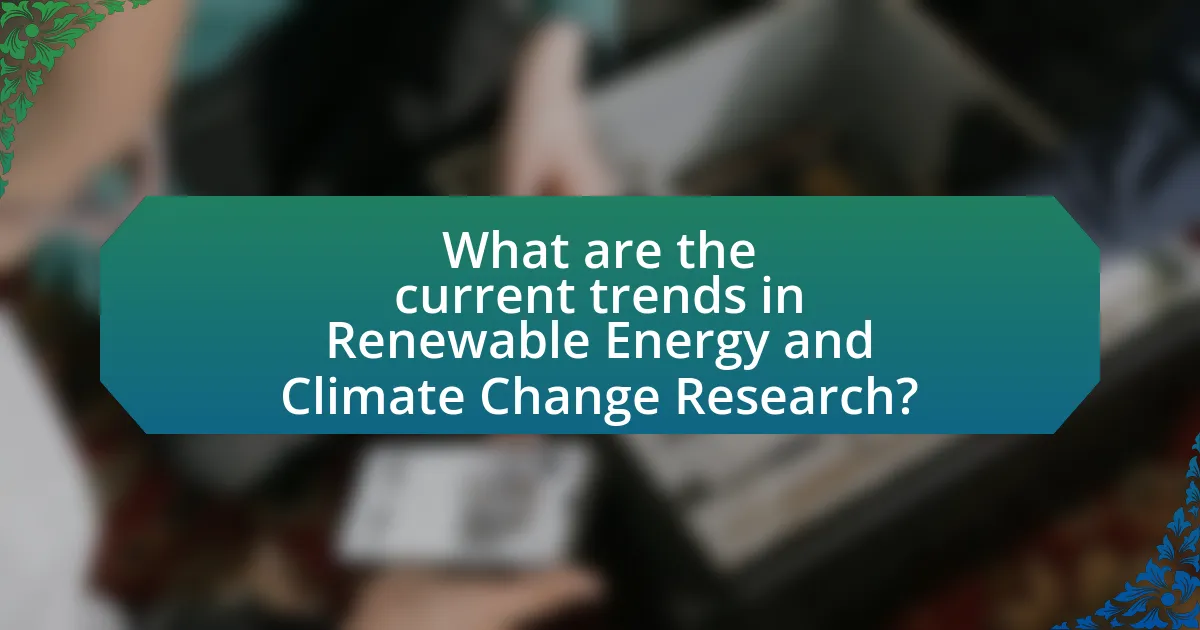
What are the current trends in Renewable Energy and Climate Change Research?
Current trends in Renewable Energy and Climate Change Research include a significant focus on the integration of artificial intelligence (AI) for optimizing energy systems, advancements in energy storage technologies, and the development of carbon capture and utilization methods. Research indicates that AI can enhance the efficiency of renewable energy sources by predicting energy demand and optimizing grid management, as evidenced by studies from the International Renewable Energy Agency. Additionally, innovations in battery technologies, such as solid-state batteries, are being explored to improve energy storage capacity and reliability, which is crucial for balancing intermittent renewable sources like solar and wind. Furthermore, carbon capture technologies are being refined to reduce greenhouse gas emissions, with projects like the Petra Nova project in Texas demonstrating the potential for large-scale implementation. These trends reflect a comprehensive approach to addressing climate change through renewable energy solutions.
What recent advancements have been made in renewable energy technologies?
Recent advancements in renewable energy technologies include significant improvements in solar panel efficiency, with some new models achieving over 25% efficiency rates. This increase is attributed to innovations in materials such as perovskite, which enhances light absorption and conversion. Additionally, wind energy technology has seen advancements in turbine design, allowing for larger blades that capture more wind energy, resulting in a 20% increase in energy output compared to previous models. Furthermore, energy storage solutions, particularly lithium-ion batteries, have improved in capacity and reduced costs by nearly 50% over the past five years, facilitating better integration of renewable sources into the energy grid. These advancements collectively contribute to a more sustainable energy landscape, addressing climate change challenges effectively.
How do these advancements influence climate change research outcomes?
Advancements in renewable energy technologies significantly enhance climate change research outcomes by providing more accurate data and modeling capabilities. These technologies, such as solar and wind energy systems, enable researchers to analyze the impacts of energy production on greenhouse gas emissions more effectively. For instance, the integration of advanced sensors and data analytics allows for real-time monitoring of emissions reductions, leading to more precise assessments of climate policies. Additionally, studies like the one published in “Nature Climate Change” by Jacobson et al. (2017) demonstrate that transitioning to 100% renewable energy can reduce global warming by limiting carbon emissions, thereby influencing research conclusions and policy recommendations.
What are the emerging technologies in renewable energy that show promise for climate change mitigation?
Emerging technologies in renewable energy that show promise for climate change mitigation include advanced solar photovoltaic systems, offshore wind energy, and energy storage solutions such as lithium-ion and solid-state batteries. Advanced solar photovoltaic systems utilize innovative materials like perovskite to enhance efficiency and reduce costs, with efficiencies exceeding 25% reported in recent studies. Offshore wind energy is expanding rapidly, with projects like the Hornsea One in the UK generating over 1.2 GW of power, enough to supply over a million homes. Energy storage solutions are critical for balancing supply and demand; lithium-ion batteries have seen a 90% reduction in costs since 2010, while solid-state batteries promise higher energy densities and safety. These technologies collectively contribute to reducing greenhouse gas emissions and enhancing energy resilience.
How is policy shaping the future of renewable energy and climate change research?
Policy is significantly shaping the future of renewable energy and climate change research by establishing regulatory frameworks and funding mechanisms that prioritize sustainable practices. For instance, the implementation of the Paris Agreement has led countries to commit to reducing greenhouse gas emissions, which in turn drives investment in renewable technologies and research initiatives. Additionally, government incentives, such as tax credits for solar and wind energy projects, have accelerated the development and deployment of clean energy solutions. According to the International Renewable Energy Agency, global renewable energy investment reached $303 billion in 2020, largely influenced by supportive policies. These policies not only foster innovation in renewable energy technologies but also enhance collaboration between public and private sectors, ensuring that climate change research is aligned with practical applications and societal needs.
What policies are currently in place to promote renewable energy adoption?
Governments worldwide have implemented various policies to promote renewable energy adoption, including feed-in tariffs, tax incentives, and renewable portfolio standards. Feed-in tariffs guarantee fixed payments for energy producers who generate electricity from renewable sources, encouraging investment in solar, wind, and biomass technologies. Tax incentives, such as the Investment Tax Credit in the United States, provide financial benefits to individuals and businesses that invest in renewable energy systems. Renewable portfolio standards require utilities to obtain a certain percentage of their energy from renewable sources, driving demand for clean energy. These policies collectively aim to reduce greenhouse gas emissions and transition to a sustainable energy future.
How do international agreements impact research funding and priorities?
International agreements significantly influence research funding and priorities by establishing collaborative frameworks and shared goals among nations. For instance, the Paris Agreement, which aims to limit global warming, encourages countries to allocate resources towards renewable energy research and climate change mitigation strategies. This is evidenced by the increase in funding for projects aligned with the agreement’s objectives, as countries commit to reducing greenhouse gas emissions and transitioning to sustainable energy sources. Additionally, international collaborations often lead to pooled funding initiatives, such as the Green Climate Fund, which supports research and development in climate-resilient technologies, thereby prioritizing research that addresses global climate challenges.
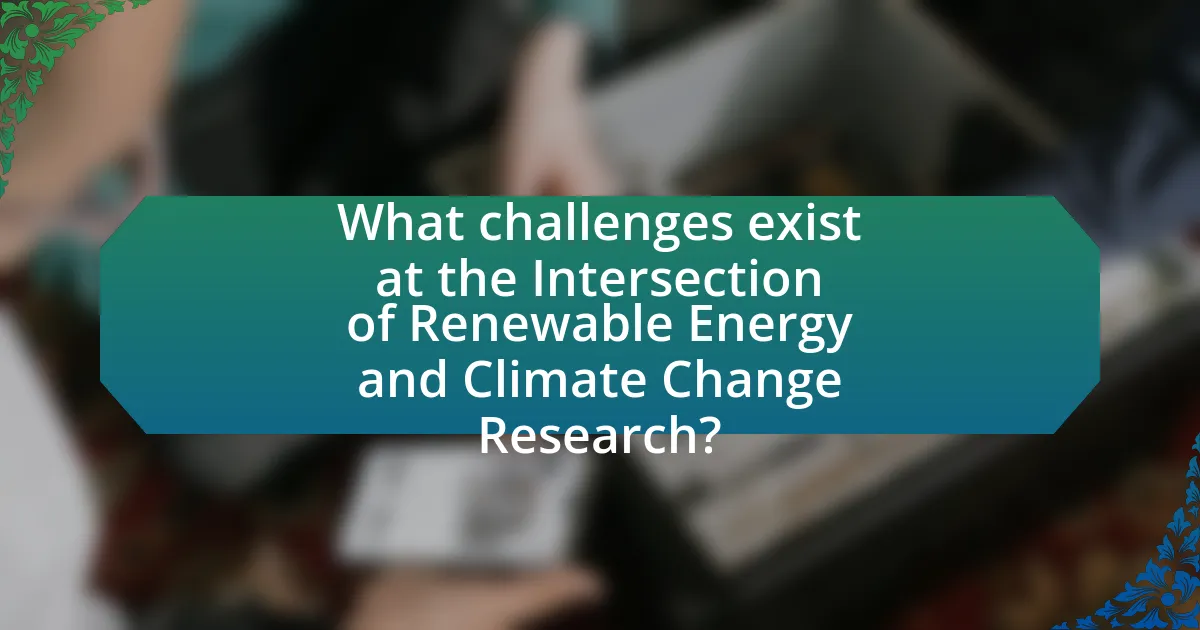
What challenges exist at the Intersection of Renewable Energy and Climate Change Research?
The challenges at the intersection of renewable energy and climate change research include technological limitations, economic barriers, and policy inconsistencies. Technological limitations arise from the need for advancements in energy storage and grid integration to effectively utilize renewable sources like solar and wind. Economic barriers are evident in the high initial investment costs for renewable infrastructure compared to fossil fuels, which can deter adoption. Policy inconsistencies, such as varying regulations and incentives across regions, create uncertainty for investors and hinder the scaling of renewable energy solutions. These challenges are critical as they directly impact the effectiveness of strategies aimed at mitigating climate change through renewable energy adoption.
What are the main barriers to the widespread adoption of renewable energy?
The main barriers to the widespread adoption of renewable energy include high initial costs, technological limitations, and regulatory challenges. High initial costs deter investment; for instance, the International Renewable Energy Agency reported that upfront costs for solar and wind installations can be significant, despite long-term savings. Technological limitations, such as energy storage and grid integration issues, hinder the reliability of renewable sources; a study by the National Renewable Energy Laboratory highlighted that current battery technologies are insufficient for large-scale energy storage. Regulatory challenges, including inconsistent policies and lack of incentives, create uncertainty for investors; according to the International Energy Agency, countries with stable regulatory frameworks see higher renewable energy adoption rates.
How do economic factors influence the transition to renewable energy sources?
Economic factors significantly influence the transition to renewable energy sources by determining the feasibility and attractiveness of investments in these technologies. For instance, the decreasing costs of solar and wind energy technologies have made them more competitive with fossil fuels; according to the International Renewable Energy Agency, the cost of solar photovoltaic (PV) systems fell by 82% between 2010 and 2019. Additionally, government policies, such as subsidies and tax incentives, can enhance the economic viability of renewable projects, encouraging private sector investment. Conversely, high initial capital costs and market volatility can hinder the transition, as seen in regions where fossil fuel subsidies remain prevalent, making renewables less appealing. Thus, economic factors play a crucial role in shaping the pace and scale of the shift towards renewable energy.
What technological challenges must be overcome to enhance renewable energy efficiency?
To enhance renewable energy efficiency, key technological challenges include improving energy storage systems, increasing conversion efficiencies, and developing smart grid technologies. Energy storage systems, such as batteries, must advance to store larger amounts of energy for longer durations, addressing the intermittent nature of renewable sources like solar and wind. For instance, current lithium-ion batteries have limitations in capacity and lifespan, necessitating research into alternatives like solid-state batteries or flow batteries.
Increasing conversion efficiencies involves optimizing the technologies used to convert renewable resources into usable energy. For example, photovoltaic cells currently have an average efficiency of around 20%, while research into multi-junction solar cells has shown potential efficiencies exceeding 40%.
Lastly, smart grid technologies are essential for managing the distribution of renewable energy. These systems must be developed to facilitate real-time data analysis and improve grid reliability, enabling better integration of diverse energy sources. The International Energy Agency has reported that enhancing grid infrastructure can significantly reduce energy losses and improve overall efficiency.
How does climate change affect renewable energy production?
Climate change significantly impacts renewable energy production by altering weather patterns, which affects the availability and efficiency of energy sources like solar, wind, and hydroelectric power. For instance, increased temperatures can reduce the efficiency of solar panels, while changing precipitation patterns can affect water levels in reservoirs used for hydroelectric power generation. According to the Intergovernmental Panel on Climate Change (IPCC), shifts in wind patterns can also lead to decreased wind energy production in certain regions. These changes highlight the vulnerability of renewable energy systems to climate variability, necessitating adaptive strategies to maintain energy reliability and efficiency.
What impacts do extreme weather events have on renewable energy infrastructure?
Extreme weather events significantly disrupt renewable energy infrastructure by causing physical damage, reducing energy production, and increasing operational costs. For instance, hurricanes can destroy wind turbines and solar panels, while flooding can damage electrical systems and transmission lines. According to a report by the National Renewable Energy Laboratory, extreme weather events have led to a 20% decrease in energy output from affected renewable sources during such incidents. Additionally, the increased frequency of these events due to climate change poses ongoing risks, necessitating enhanced resilience measures in the design and maintenance of renewable energy systems.
How can renewable energy systems be designed to be resilient to climate change effects?
Renewable energy systems can be designed to be resilient to climate change effects by incorporating adaptive technologies, diversified energy sources, and robust infrastructure. Adaptive technologies, such as smart grids, allow for real-time monitoring and management of energy supply and demand, enhancing system flexibility in response to climate variability. Diversifying energy sources, including solar, wind, and hydro, mitigates risks associated with reliance on a single source, ensuring a more stable energy supply during extreme weather events. Additionally, robust infrastructure, built to withstand climate impacts like flooding and high winds, is essential for maintaining operational integrity. For instance, the National Renewable Energy Laboratory reports that integrating energy storage solutions can further enhance resilience by providing backup power during disruptions, thus ensuring continuous energy availability.
What practical steps can be taken to enhance the intersection of renewable energy and climate change research?
To enhance the intersection of renewable energy and climate change research, collaborative interdisciplinary research initiatives should be established. These initiatives can bring together experts from various fields, such as environmental science, engineering, economics, and policy-making, to address complex challenges. For instance, the International Renewable Energy Agency (IRENA) emphasizes the importance of integrating renewable energy technologies into climate strategies, highlighting that such collaboration can lead to innovative solutions and more effective policy frameworks. Additionally, funding programs that specifically target joint research projects between renewable energy and climate change sectors can facilitate knowledge sharing and accelerate advancements in both areas.
How can individuals contribute to renewable energy initiatives in their communities?
Individuals can contribute to renewable energy initiatives in their communities by participating in local solar or wind energy projects. For instance, community solar programs allow residents to invest in solar farms, which can reduce energy costs and increase renewable energy usage. According to the National Renewable Energy Laboratory, community solar can increase access to solar energy for those who may not have suitable rooftops, thus promoting wider adoption of renewable energy sources. Additionally, individuals can advocate for local policies that support renewable energy development, such as tax incentives for renewable installations or zoning changes that facilitate wind farms. Engaging in educational outreach about the benefits of renewable energy can also foster community support and participation in these initiatives.
What best practices should researchers follow to ensure impactful findings in this field?
Researchers should prioritize interdisciplinary collaboration to ensure impactful findings in the intersection of renewable energy and climate change research. By engaging experts from various fields such as environmental science, engineering, economics, and social sciences, researchers can develop comprehensive solutions that address complex challenges. For instance, a study published in “Nature Climate Change” by Riahi et al. (2017) highlights that integrated approaches significantly enhance the effectiveness of climate mitigation strategies. Additionally, researchers should focus on data transparency and reproducibility, as demonstrated by the increasing emphasis on open data initiatives, which facilitate validation and broader application of findings. Lastly, aligning research objectives with policy needs ensures that findings are relevant and actionable, as evidenced by the Intergovernmental Panel on Climate Change (IPCC) reports that directly inform global climate policies.
